-

新人教版高中英语选修2Unit 1 Science and Scientists-Using langauge教学设计
This happens because the dish soap molecules have a strong negative charge, and the milk molecules have a strong positive charge. Like magnets, these molecules are attracted to each other, and so they appear to move around on the plate, taking the food coloring with them, making it look like the colors are quickly moving to escape from the soap.Listening text:? Judy: Oh, I'm so sorry that you were ill and couldn't come with us on our field trip. How are you feeling now? Better?? Bill: Much better, thanks. But how was it?? Judy: Wonderful! I especially liked an area of the museum called Light Games.it was really cool. They had a hall of mirrors where I could see myself reflected thousands of times!? Bill: A hall of mirrors can be a lot of fun. What else did they have?? Judy: Well, they had an experiment where we looked at a blue screen for a while, and then suddenly we could see tiny bright lights moving around on it. You'll never guess what those bright lights were!? Bill: Come on, tell me!? Judy: They were our own blood cells. For some reason, our eyes play tricks on us when we look at a blue screen, and we can see our own blood cells moving around like little lights! But there was another thing I liked better. I stood in front of a white light, and it cast different shadows of me in every color of the rainbow!? Bill: Oh, I wish I had been there. Tell me more!? Judy: Well, they had another area for sound. They had a giant piano keyboard that you could use your feet to play. But then, instead of playing the sounds of a piano, it played the voices of classical singers! Then they had a giant dish, and when you spoke into it, it reflected the sound back and made it louder. You could use it to speak in a whisper to someone 17 meters away.? Bill: It all sounds so cool. I wish I could have gone with you? Judy: I know, but we can go together this weekend. I'd love to go there again!? Bill: That sounds like a great idea!

新人教版高中英语选修2Unit 2 Bridging Cultures-Discovering useful structures教学设计
The grammar of this unit is designed to review noun clauses. Sentences that use nouns in a sentence are called noun clauses. Nominal clauses can act as subject, object, predicate, appositive and other components in compound sentences. According to the above-mentioned different grammatical functions, nominal clauses are divided into subject clause, object clause, predicate clause and appositive clause. In this unit, we will review the three kinds of nominal clauses. Appositive clauses are not required to be mastered in the optional compulsory stage, so they are not involved.1. Guide the students to judge the compound sentences and determine the composition of the clauses in the sentence.2. Instruct students to try to learn grammar by generalizing grammar rules, controlling written practice, and semi-open oral output.3. Inspire the students to systematize the function and usage of noun clause1.Instruct students to try to learn grammar by generalizing grammar rules, controlling written practice, and semi-open oral output.2.Inspire the students to systematize the function and usage of noun clauseStep1: The teacher ask studetns to find out more nominal clauses from the reading passage and udnerline the nominal clauses.

新人教版高中英语选修2Unit 3 Food and Culture-Discovering useful structures教学设计
The newspaper reported more than 100 people had been killed in the thunderstorm.报纸报道说有一百多人在暴风雨中丧生。(2)before、when、by the time、until、after、once等引导的时间状语从句的谓语是一般过去时,以及by、before后面接过去的时间时,主句动作发生在从句的动作或过去的时间之前且表示被动时,要用过去完成时的被动语态。By the time my brother was 10, he had been sent to Italy.我弟弟10岁前就已经被送到意大利了。Tons of rice had been produced by the end of last month. 到上月底已生产了好几吨大米。(3) It was the first/second/last ... time that ...句中that引导的定语从句中,主语与谓语构成被动关系时,要用过去完成时的被动语态。It was the first time that I had seen the night fact to face in one and a half years. 这是我一年半以来第一次亲眼目睹夜晚的景色。(4)在虚拟语气中,条件句表示与过去事实相反,且主语与谓语构成被动关系时,要用过去完成时的被动语态。If I had been instructed by him earlier, I would have finished the task.如果我早一点得到他的指示,我早就完成这项任务了。If I had hurried, I wouldn't have missed the train.如果我快点的话,我就不会误了火车。If you had been at the party, you would have met him. 如果你去了晚会,你就会见到他的。

新人教版高中英语选修2Unit 5 First Aid-Discovering useful structures教学设计
You have no excuse for not going.你没有理由不去。He was punished for not having finished his homework.他因未完成作业而受到惩罚。2.动词ing形式复合结构由物主代词或人称代词宾格、名词所有格或普通格加动词ing,即“sb./sb.'s+doing”构成。动词ing形式的复合结构实际上是给动词ing形式加了一个逻辑主语。动词ing形式的复合结构有四种形式:①形容词性物主代词+动词ing②名词所有格+动词ing③代词宾格+动词ing④名词+动词ingHer coming to help encouraged all of us.她来帮忙鼓舞了我们所有人。The baby was made awake by the door suddenly shutting.这个婴儿被突然的关门声吵醒了。Can you imagine him/Jack cooking at home?你能想象他/杰克在家做饭的样子吗?无生命名词无论是作主语还是作宾语都不能用第②种形式。Tom's winning first prize last year impressed me a lot.汤姆去年得了一等奖使我印象深刻。Do you mind my/me/Jack's/Jack leaving now?你介意我/杰克现在离开吗?Excuse me for my not coming on time.很抱歉我没能按时来。His father's being ill made him worried.他父亲病了,他很担心。We are looking forward to the singer's/the singer to give us a concert.我们盼望着这位歌手来给我们举办一场演唱会。

新人教版高中英语必修3Unit 2 Morals and Virtues-Listening &Speaking&Talking教学设计
Example:One day, a poor boy who was trying to pay his way through school by sending newspapers door to door found that he only had one dime(一角)left. He was so hungry that he decided to beg for a meal at the next house.However, he lost his nerve when a lovely young woman opened the door. Instead of a meal he asked for a drink of water. She thought he looked hungry so she brought him a large glass of milk. He drank it slowly, and then asked, “How much do I owe you?” “You don’t owe me anything,” she replied, “Mother has taught me never to accept pay for a kindness.” “Then I thank you from the bottom of my heart.” With these words, Howard Kelly left that house.Years later the woman became badly ill and was finally sent to the hospital in a big city. Dr. Howard Kelly, now famous, was called in. When he heard the name of the town she came from, a strange light filled his eyes. Dressed in his doctor’s clothes, Dr. Kelly went into her room and recognized her at once. From that day on, he gave special attention to her, and decided to do his best to save her life.At last the woman was saved. Dr. Kelly asked the business office to pass the final bill to him. He looked at it and then wrote something on the side. The bill was sent to the woman’s room. She was afraid to open it because she was sure that it would take the rest of her life to pay for it off. Finally she looked, and the note on the side of the bill caught her attention. She read these words: “Paid in full with a glass of milk, Dr. Howard Kelly.” Tear of joy flooded her eyes.

新人教版高中英语必修3Unit 3 Diverse Cultures-Reading for Writing教学设计
The topic of this part is “Describe a place with distinctive cultural identity”.This section focuses on Chinese culture by introducing Chinatown, whose purpose is to show the relationship between the Chinese culture and American culture. The Chinese culture in Chinatown is an important part of American culture. Chinatown is an important window of spreading Chinese culture and the spirit homeland of oversea Chinese, where foreigners can experience Chinese culture by themselves.Concretely, the title is “Welcome to Chinatown!”, from which we can know that the article aims at introducing Chinatown. The author used the “Introduction--Body Paragraph--Conclusion” to describe the people, language, architecture, business, famous food and drinks and people’s activities, which can be a centre for Chinese culture and shows its unique charm.1. Read quickly to get main idea; read carefully to get the detailed information.2. Learn the characteristics of writing and language.3. Learn to introduce your own town according to the text.4. Learn to correct others’ writing.1. Learn the characteristics of writing and language.2. Learn to introduce your own town according to the text.Step 1 Lead in ---Small talkIn the reading part, we mentioned the Chinatown of San Francisco. How much do you know about Chinatown of San Francisco ?Chinatown is a main living place for Chinese immigrants, where you can see many Chinese-style buildings, costumes, operas, restaurants, music and even hear Chinese.Step 2 Before reading ---Predict the contentWhat is the writer’s purpose of writing this text ? How do you know ?From the title(Welcome to Chinatown) and some key words from the text(tourist, visit, visitors, experience), we can know the purpose of the text is to introduce Chinatown and show the relationship between Chinese culture and American culture.

新人教版高中英语必修3Unit 3 Diverse Cultures-Reading and Thinking教学设计
Discuss these questions in groups.Q1: Have you ever been to a place that has a diverse culture ? What do you think about the culture diversity ?One culturally diverse place that I have been to is Harbin, the capital city of Heilongjiang Province. I went there last year with my family to see the Ice and Snow Festival, and I was amazed at how the culture as different to most other Chinese cities. There is a big Russian influence there, with beautiful Russian architecture and lots of interesting restaurants. I learnt that Harbin is called “the Oriental Moscow” and that many Russians settled there to help build the railway over 100 years ago.Q2: What are the benefits and challenges of cultural diversity ?The benefits: People are able to experience a wide variety of cultures, making their lives more interesting, and it can deepen the feelings for our national culture, it is also helpful for us to learn about other outstanding culture, which helps improve the ability to respect others. The challenges: People may have trouble communicating or understanding each other, and it may lead to disappearance of some civilizations and even make some people think “The western moon is rounder than his own.”Step 7 Post reading---RetellComplete the passage according to the text.Today, I arrived back in San Francisco, and it feels good (1) _____(be) back in the city again. The city succeeded in (2)_________ (rebuild) itself after the earthquake that (3)________ (occur) in 1906, and I stayed in the Mission District, enjoying some delicious noodles mixed with cultures. In the afternoon, I headed to a local museum (4)____ showed the historical changes in California. During the gold rush, many Chinese arrived, and some opened up shops and restaurants in Chinatown to earn a (5)_____ (live). Many others worked on (6)______ (farm), joined the gold rush, or went to build the railway that connected California to the east. The museum showed us (7)____ America was built by immigrants from (8)________ (difference) countries and cultures. In the evening, I went to Chinatown, and ate in a Cantonese restaurant that served food on (9)________(beauty) china plates. Tomorrow evening, I’m going to (10)__ jazz bar in the Richmond District. 答案:1. to be 2. rebuilding 3. occurred 4. that 5.living6. farms 7.how 8. different 9. beautiful 10. a

新人教版高中英语选修2Unit 1 Science and Scientists-Reading and thinking教学设计
Step 5: After learning the text, discuss with your peers about the following questions:1.John Snow believed Idea 2 was right. How did he finally prove it?2. Do you think John Snow would have solved this problem without the map?3. Cholera is a 19th century disease. What disease do you think is similar to cholera today?SARS and Covid-19 because they are both deadly and fatally infectious, have an unknown cause and need serious public health care to solve them urgently.keys:1. John Snow finally proved his idea because he found an outbreak that was clearly related to cholera, collected information and was able to tie cases outside the area to the polluted water.2. No. The map helped John Snow organize his ideas. He was able to identify those households that had had many deaths and check their water-drinking habits. He identified those houses that had had no deaths and surveyed their drinking habits. The evidence clearly pointed to the polluted water being the cause.3. SARS and Covid-19 because they are both deadly and fatally infectious, have an unknown cause and need serious public health care to solve them urgently.Step 6: Consolidate what you have learned by filling in the blanks:John Snow was a well-known _1___ in London in the _2__ century. He wanted to find the _3_____ of cholera in order to help people ___4_____ it. In 1854 when a cholera __5__ London, he began to gather information. He ___6__ on a map ___7___ all the dead people had lived and he found that many people who had ___8____ (drink) the dirty water from the __9____ died. So he decided that the polluted water ___10____ cholera. He suggested that the ___11__ of all water supplies should be _12______ and new methods of dealing with ____13___ water be found. Finally, “King Cholera” was __14_____.Keys: 1. doctor 2. 19th 3.cause 4.infected with 5.hit 6.marked 7.where 8.drunk 9.pump 10.carried 11.source 12.examined 13.polluted 14.defeatedHomework: Retell the text after class and preview its language points

新人教版高中英语选修2Unit 3 Food and Culture-Reading and thinking教学设计
The discourse explores the link between food and culture from a foreign’s perspective and it records some authentic Chinese food and illustrates the cultural meaning, gerography features and historic tradition that the food reflects. It is aimed to lead students to understand and think about the connection between food and culture. While teaching, the teacher should instruct students to find out the writing order and the writer’s experieces and feelings towards Chinese food and culture.1.Guide the students to read the text, sort out the information and dig out the topic.2.Understand the cultural connotation, regional characteristics and historical tradition of Chinese cuisine3.Understand and explore the relationship between food and people's personality4.Guide the students to use the cohesive words in the text5.Lead students to accurately grasp the real meaning of the information and improve the overall understanding ability by understanding the implied meaning behind the text.1. Enable the Ss to understand the structure and the writing style of the passage well.2. Lead the Ss to understand and think further about the connection between food and geography and local character traits.Step1: Prediction before reading. Before you read, look at the title, and the picture. What do you think this article is about?keys:It is about various culture and cuisine about a place or some countries.
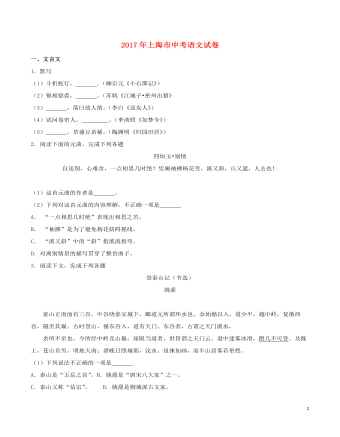
上海市2017年中考语文真题试题(含解析)
泰山正南面有三谷。中谷绕泰安城下,郦道元所谓环水也。余始循以入,道少半,越中岭,复循西谷,隧至其巅。古时登山,循东谷入,道有天门。东谷者,古谓之天门溪水, 余所不至也。今所经中岭及山巅,崖限当道者,世皆谓之天门云。道中迷雾冰滑,蹬几不可登。及既上,苍山负雪,明烛天南;望晚日照城郭,汶水、徂徕如画,而半山居雾若带然。

人教版高中历史必修3西方人文主义思想的起源说课稿
苏格拉底把装有毒酒的杯子举到胸口,平静地说:“分手的时候到了,我将死,你们活下来,是谁的选择好,只有天知道。”说毕,一口喝干了毒酒。(2) 苏格拉底临死前对一个叫克力同的人说了这样一番话。克力同,我告诉你,这几天一直有一个神的声音在我心中晓喻我,他说:“苏格拉底,还是听我们的建议吧,我们是你的卫士。不要考虑你的子女、生命或其他东西胜过考虑什么是公正。……事实上你就要离开这里了。当你去死的时候,你是个牺牲品,但不是我们所犯错误的牺牲品,而是你同胞所犯错误的牺牲品。但你若用这种可耻的方法逃避,以错还错,以恶报恶,践踏你自己和我们订立的协议合约,那么你伤害了你最不应该伤害的,包括你自己、你的朋友、你的国家,还有我们。到那时,你活着面对我们的愤怒,你死后我们的兄弟、冥府里的法律也不会热情欢迎你;因为它们知道你试图尽力摧毁我们。别接受克力同的建议,听我们的劝告吧。”

人教A版高中数学必修一两角和与差的正弦、余弦和正切公式教学设计(2)
本节内容是三角恒等变形的基础,是正弦线、余弦线和诱导公式等知识的延伸,同时,它又是两角和、差、倍、半角等公式的“源头”。两角和与差的正弦、余弦、正切是本章的重要内容,对于三角变换、三角恒等式的证明和三角函数式的化简、求值等三角问题的解决有着重要的支撑作用。 课程目标1、能够推导出两角和与差的正弦、余弦、正切公式并能应用; 2、掌握二倍角公式及变形公式,能灵活运用二倍角公式解决有关的化简、求值、证明问题.数学学科素养1.数学抽象:两角和与差的正弦、余弦和正切公式; 2.逻辑推理: 运用公式解决基本三角函数式的化简、证明等问题;3.数学运算:运用公式解决基本三角函数式求值问题.4.数学建模:学生体会到一般与特殊,换元等数学思想在三角恒等变换中的作用。.

人教A版高中数学必修一两角和与差的正弦、余弦和正切公式教学设计(1)
本节课选自《普通高中课程标准实验教科书数学必修1本(A版)》第五章的5.5.1 两角和与差的正弦、余弦和正切公式。本节的主要内容是由两角差的余弦公式的推导,运用诱导公式、同角三角函数的基本关系和代数变形,得到其它的和差角公式。让学生感受数形结合及转化的思想方法。发展学生数学直观、数学抽象、逻辑推理、数学建模的核心素养。课程目标 学科素养1.了解两角差的余弦公式的推导过程.2.掌握由两角差的余弦公式推导出两角和的余弦公式及两角和与差的正弦、正切公式.3.熟悉两角和与差的正弦、余弦、正切公式的灵活运用,了解公式的正用、逆用以及角的变换的常用方法.4.通过正切函数图像与性质的探究,培养学生数形结合和类比的思想方法。 a.数学抽象:公式的推导;b.逻辑推理:公式之间的联系;c.数学运算:运用和差角角公式求值;d.直观想象:两角差的余弦公式的推导;e.数学建模:公式的灵活运用;
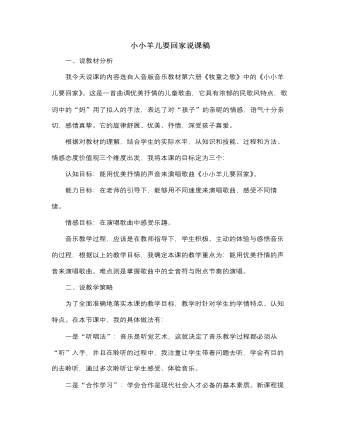
人音版小学音乐三年级下册小小羊儿要回家说课稿
(设计意图:给学生创设了一个愉快轻松的真情空间。这一环节给了学生大胆表达自己的感受,从各自不同的角度来感悟,培养了审美能力,使其积极性、自觉性、主动性得到了充分体现,活跃了课堂气氛,收到事半功倍的效果。至此,课堂推向高潮。最后,再次播放歌曲《小小羊儿要回家》,让孩子们把歌声带出教室,奔向属于他们的天地。五、教学说明各位老师、说话说:教学有法,但无定法,贵在得法。在本课教学设计中,我精心组织开放而有活力的课堂教学,尊重学生独特的情感与创造体验,始终贯穿“学生是学习和发展的主体”这一教育理念。采用多元化的教学手段,融音乐、表演为一体,发挥学生的创造能力,通过唱、听等丰富学生的情感体验,使学生的音乐审美素养得到全面提高,创设一个自由民主,宽松和谐,愉快互动的真情空间。突出学生活动、教师引导、共同探讨、总结求精的教学风格,使艺术课堂焕发勃勃生机。教学研究永无止境,我相信,没有最好,只有更好!
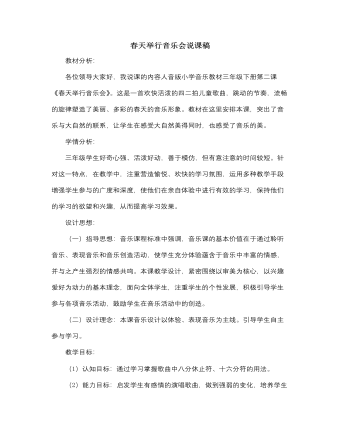
人音版小学音乐三年级下册春天举行音乐会说课稿
三、深入学习体验春之歌声——唱春天在新歌学唱环节,仍然以春天音乐会为主线,通过老师的导入“今天咱们就来学唱这次音乐会的主题歌《春天举行音乐会》,教师进行范唱,进而激发学好主题歌的愿望,再通过用“啦”模唱歌谱、有节奏的朗读歌词增强对歌曲的了解,音乐会节目的形式多样,除了它们四个音乐家独奏之外,还有合奏的地方,再提出滴答答答答︱沙沙0沙|沙沙?|轰隆隆隆隆|哗啦0啦|哗啦?|难点乐句中节奏的变化即十六分音符的用法,在学唱歌曲过程中,采用分角色接龙表演唱等形式,让学生在聆听中主动感受、体验歌曲的意境,并从歌曲的速度、力度等音乐要素出发,引导学生在参与表演中感受歌曲,感悟春雨的轻柔、春雷的有力,春水的热情、春笋的自豪应如何唱,重视学生思维的创造和发展过程,让学生明白怎样才能更好的表现歌曲,而不是单纯的停留在只是会唱歌曲的基础上,在此过程中进一步的培养了学生的音乐审美技能。四、创造表现,再现春之和谐。——颂春天
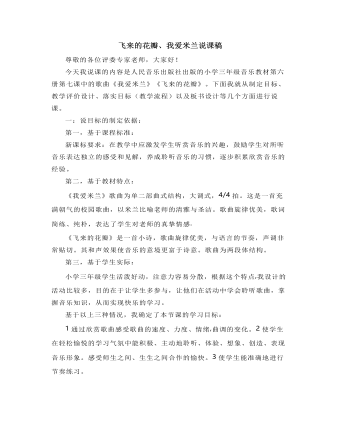
人音版小学音乐三年级下册飞来的花瓣、我爱米兰说课稿
1、运用橡皮筋听音乐学生讨论并回答。《我爱米兰》曲调跳荡《飞来的花瓣》曲调平稳2、运用学生自带的钥匙链等能发出声音的第二次欣赏《我爱米兰》《飞来的花瓣》老师引导学生分析乐曲节奏的不同《我爱米兰》节奏紧密《飞来的花瓣》节奏宽松6、运用身体动作第三次次欣赏《我爱米兰》《飞来的花瓣》老师引导学生分析乐曲速度的不同《我爱米兰》速度稍快《飞来的花瓣》速度中速7、运用彩色纸第四次欣赏《我爱米兰》《飞来的花瓣》老师引导学生分析乐曲情绪的不同《我爱米兰》情绪明快《飞来的花瓣》情绪深情(五)拓展延伸这一环节主要是让学生积累课外的音乐知识,拓宽学生的文化视野,提高学生的人文素养。最后,请大家用自己的话说说对歌曲的理解?师生在《长大后我就成了你》的歌曲声中结束本课。六:板书设计:层次分明。对比清晰谢谢大家!我的说课到此结束,敬请各位评委老师多多给予指导。
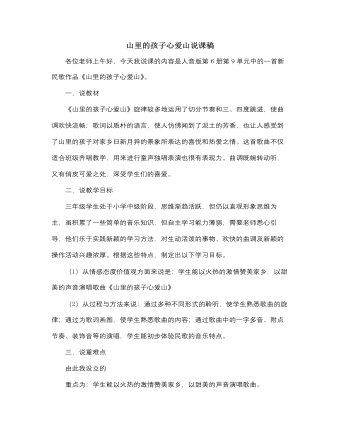
人音版小学音乐三年级下册山里的孩子心爱山说课稿
(1)喊:喂--喂;你好啊--你好啊;(2)唱:有旋律的,2468小节的旋律"喂喂喂""哗啦啦""叮咚叮咚"(3)这些都可能是山里的什么声音?师生讨论(4)师生接唱"大山的回声--喂喂喂;风吹树叶--哗啦啦;山里的泉水--叮咚叮咚;山里的歌声--多动听"连接话题:如果你到了山里,你最想做什么事情?那我们就去山里摘一摘果子吧!第二部分学唱部分1、播放伴奏音乐,师生一起根据音高,做摘果子和吃果子的律动2、再次播放伴奏,边哼唱边表演摘果子动作过渡句:自己摘的果子可真好吃啊,我们以拉歌的形式把山里的小伙伴也叫出来吧!3、第三遍播放伴奏,教师范唱前8小节4、熟悉歌词以画图的方式,将歌词展现出来山里的孩子心爱山,从小就生长在山路间,山里的泉水香喷喷,山里的果子,肥又甜,山里的孩子心爱山,山里有我的好家园,山上是我们村里的树,山下是我们村里的田。
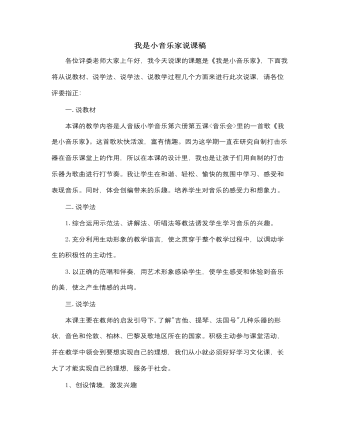
人音版小学音乐三年级下册我是小音乐家说课稿
都说教学是一门遗憾的艺术,在总结这堂课优点的同时我也清醒地认识到了自己的不足。比如在歌曲教学中,有不少节奏难点,如"0勃隆︱砰砰砰勃隆︱砰砰砰"中的八分休止符及十六分音符节奏的弱起衬词"勃隆",是比较难处理的,虽然通过反复的听唱,学生掌握得比较到位,但是我觉得是缺少解决方法的。课后我在思考,如果为了不让学生将"勃隆"两字常到强拍位置而让学生只唱"砰砰砰",将八反休止符及"勃隆"放在心里默唱,这样,更能确定"砰砰砰"的准确拍位,同时在默唱时也能聆听"勃隆"两字的弱起感觉。又比如在"跳?哟唱哟"这一字多音的乐句,处理最不好,尽管我进行了多次范唱,节奏仍有错误,学生还是很明显地将"跳?哟唱哟"唱成了"跳哟唱哟"。课后我思考在教学生唱"跳"字时做一个伸懒腰的动作,并在"531︱21︱"中的"3"音处加个"ao"音,节奏,那么难点解决了嘛!
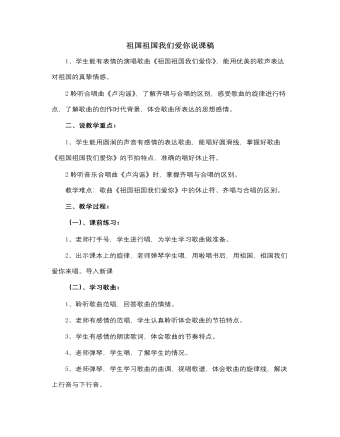
人音版小学音乐三年级下册祖国祖国我们爱你说课稿
5、加入二声部让学生进行演唱,注意声部间的和谐。6、学生分组表演并进行交换。告诉学生以上的两种演唱形式分别是齐唱与合唱。7、聆听《卢沟谣》:8、学生听音乐,歌曲分为几部分?歌曲表现的是什么内容?9、出示歌词,永定河、卢沟桥、宛平城是什么?简介卢沟桥事变。学生有感情的读歌词,10、听歌曲第一部分,体会歌曲的演唱形式,并进行学唱。11、听歌曲的第二部分,体会演唱形式,与第一段相比,情绪有什么变化?(合唱部分音区变高,节奏舒展,力度增强,情绪更激昂。)12、完整聆听歌曲,跟着哼唱。(三)、小结:听着这首歌曲,欣赏着这样的画面,你们是不是也知道珍惜今天的幸福生活来之不易呢?你是不是更爱我们的祖国呢?(放歌曲《祖国祖国我们爱你》结束本课)
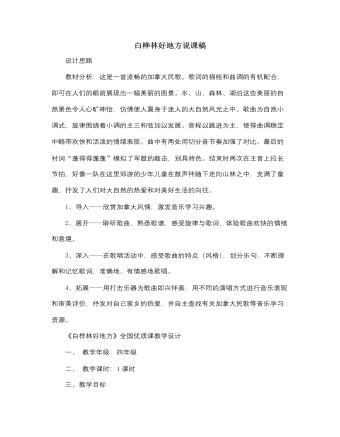
人音版小学音乐四年级下册白桦林好地方说课稿
3、想象歌词意境,自配动作,有表情地学唱歌曲。(1)引导学生为第一段每一句歌词配上动作,老师做适当提示(可为第一句歌词做示范)。(学生想象思考,并请个别学生作示范引导大家一起做),将第一段歌词连起来唱一遍,用动作加强音乐记忆和情感体验。(2)第二段歌词的学唱采用师生“接唱”,可老师唱前一句,学生后后一句,唱一遍,然后再交换。结尾句大家一起唱。(提示放慢速度,轻轻试唱。交换唱一遍)(3)第三段歌词学生自主学习。采用“接唱”的形式,男女生分组,或将学生分成两组,进行接唱,情绪豪迈的部分可引导男生唱,柔和抒情的部分女生唱,结尾句大家一起唱。(教师引导学生自己思考,自己处理)4、学生小结学习经验,提出演唱方案,并引导学生找出歌曲中的音乐符号f、mp、>、渐弱,在演唱时加以运用和注意表现。)最好将这些符号做成卡片!用力度变化的方法,演唱整首歌一遍,(可加动作、接唱等)

